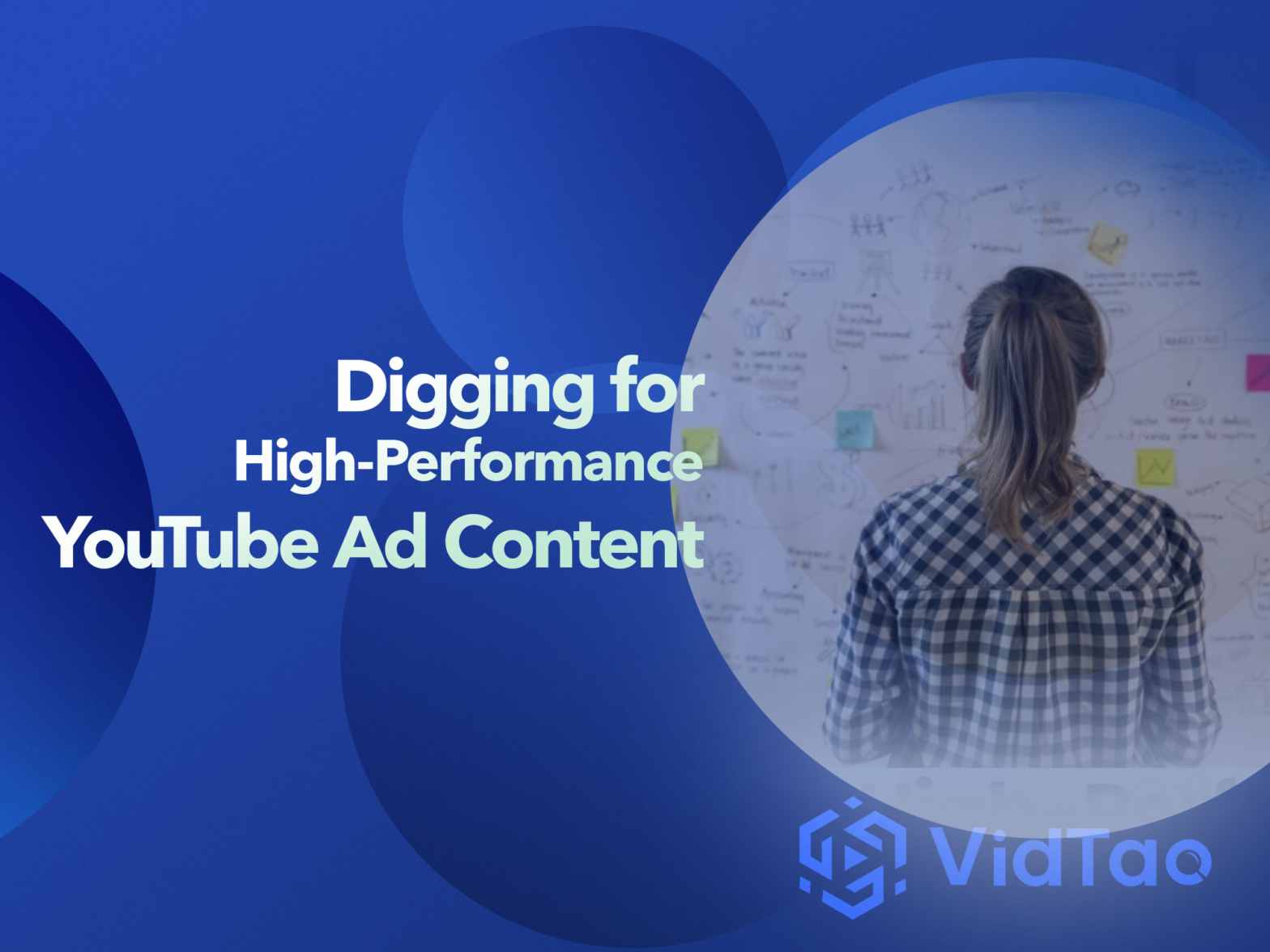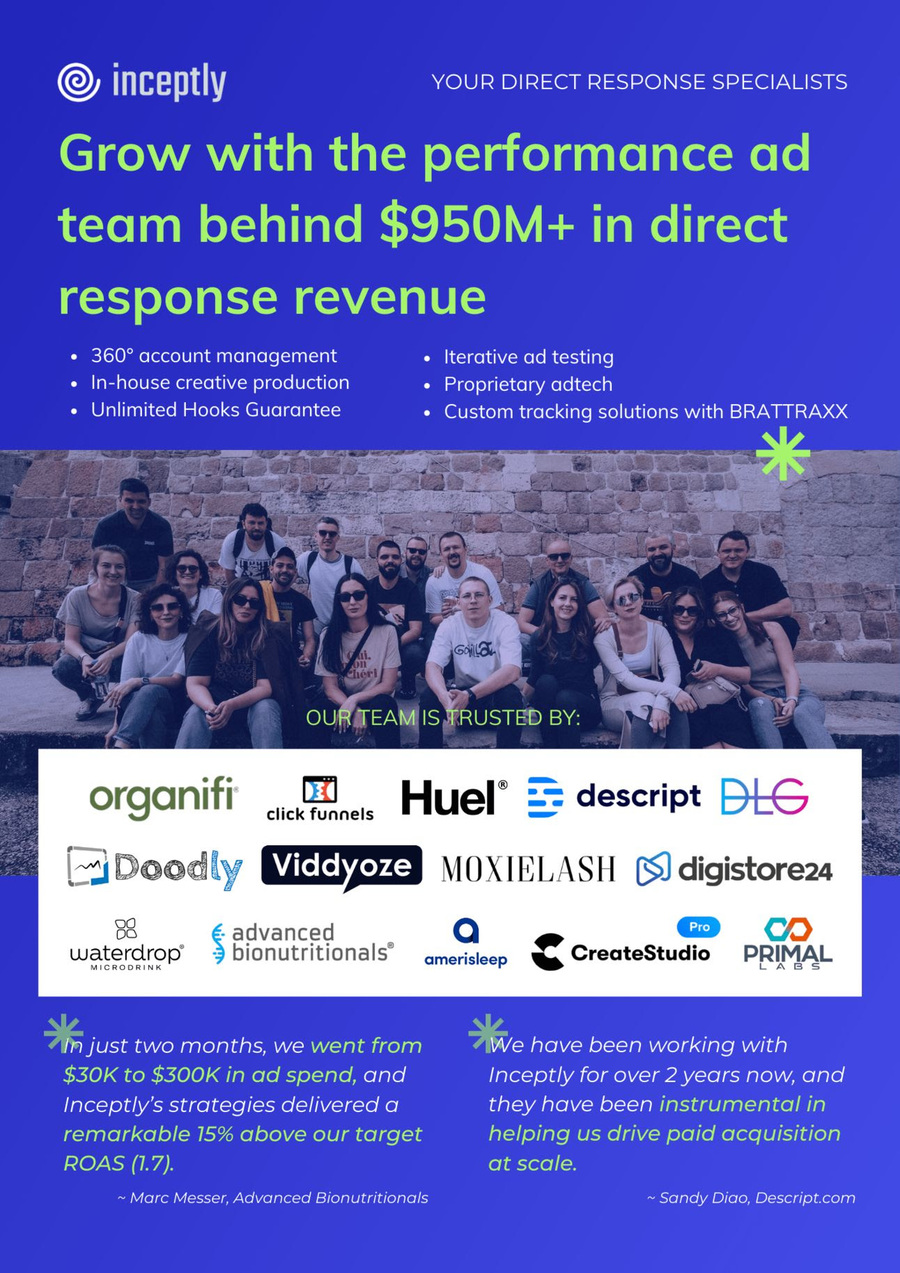Mining VidTao for Gold: Part 2: Digging for High-Performance YouTube Ad Content
Question: Noom spent $131 million + on YouTube ads…
- What can we learn from their YouTube ads?
- How can we apply that to Found’s YouTube ads?
Now that we have some good initial targeting in place, let’s take a look at Noom’s ads to help us build out the YouTube ads we’ll use to scale Found.
Let’s open up VidTao and look at Noom’s YouTube ads:
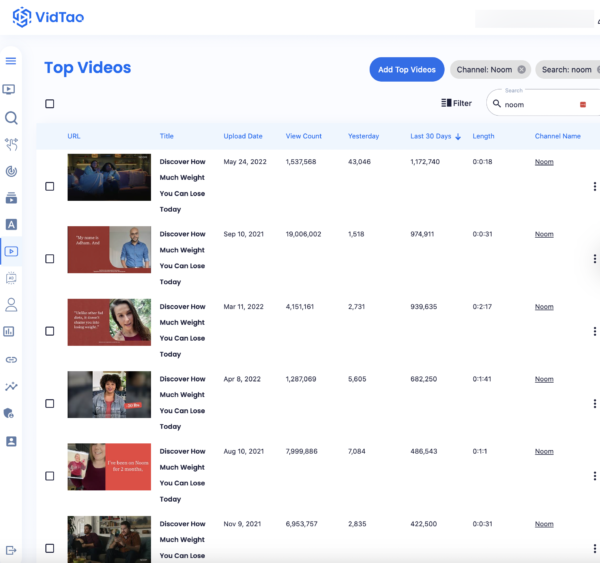
You’ll see dozens of live YouTube ads inside VidTao.
Here for example is one of Noom’s ads spending over $2k per day:
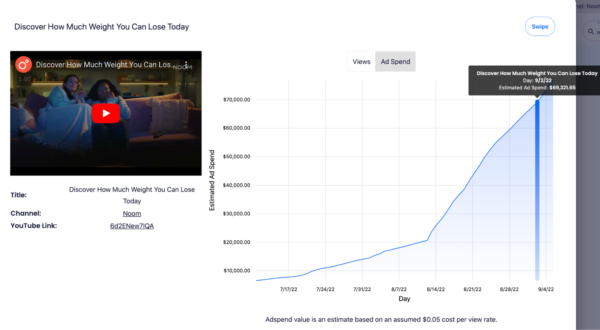
VidTao gives us a great look at what Noom is running right now on YouTube.
Specifically, let’s look at:
- What can we learn from Noom’s YouTube ads?
- How can we apply this to Found’s ads?
What can we learn from Noom’s YouTube ads?
“Imitate first, innovate second.”
Maybe you’ve heard this quote before. No idea who said it first, but it applies here.
Don’t take it the wrong way: We’re not going to copy Noom’s ads.
But we definitely want to see what elements are working for Noom, and model/apply these learnings for our first iterations of Found’s YouTube ads.
Let’s take a closer look…
Key Takeaway #1 - Overwhelming “Stacked” Social Proof in the First 10 Seconds
First, it’s crucial to keep in mind YouTube In-stream ad structure:
Notice:
- At 5 seconds: The Skip Ad button appears.
- At 10 seconds: An “Engagement” takes place when someone watches 10 seconds or clicks on your ad (all things being equal, higher engagement = cheaper traffic + lower CAC. More on that in a future post…)
These 2 milestones are particularly important when it comes to dissecting exactly why Noom’s ads have been so successful.
Your YouTube ad’s first goal:
Get viewers to stick around past 10 seconds.
How does Noom do this?
By packing those first 10 seconds with overwhelming, “Stacked” Social Proof.
Let’s see this point in action with Noom’s top performing YouTube ad from these past 30 days:
Here is the ad.
Notice how In the first 10 seconds, we are hit with 3 pieces of overwhelming proof:
Noom’s First 10 seconds: Overwhelming “Stacked” Social Proof
00:00 - “Since I started Noom, I’ve lost 70 lbs” - Darin
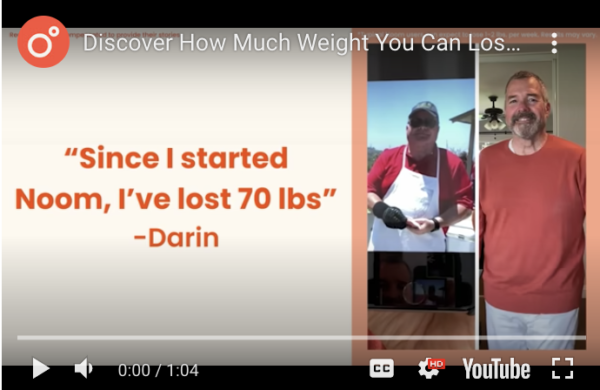
00:02 - “I’ve lost 97 lbs with Noom” - Jeremy
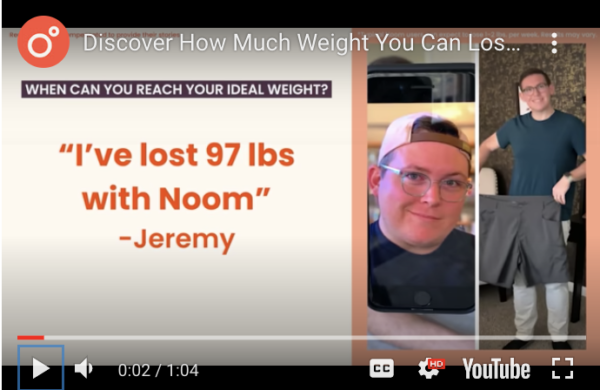
00:05 - “I’ve lost 92 lbs on Noom” - Mark

This video catches relevant user attention right away with these amazing results. Plus, the clips’ User Generated Content (UGC) format makes the stories believable.
Noom has done a great job here, and many viewers will have stuck around past 10 seconds, giving Noom more time to make their pitch.
Viewers are left thinking:
“This Noom thing clearly works. These results are amazing…”
But this begs the next question:
“Will it work for me?”
Because here’s the thing:
The average adult tries 126 different diets in their lifetime (not to mention other approaches like exercise programs, supplements, etc.)
Chances are, this is NOT the first time our viewer has tried to lose weight.
At this point they are probably having thoughts like “I’ve tried doing XYZ before to lose weight, and it didn’t work, because ABC…”
Which leads us to the next major takeaway from Noom’s videos…
Key Takeaway #2 - Handling Major Objections with UGC Micro Case Studies
How does Noom skillfully handle these objections?
With simplified UGC “micro case studies” showing that Noom users have successfully overcome these same challenges and used the app to lose weight.
(Again - note how the UGC format lends believability to what these users are saying…)
Overcoming Objections with UGC Micro Case Studies
Timestamp: 00:06 - 00:16
Objection: Trouble with Stress/Comfort Eating
“I'm a stress eater and I'm a comfort eater and I looked for food to fill the void. I tried Noom and I lost 10 pounds which to me was huge. I hadn't seen the scale move in so long.”
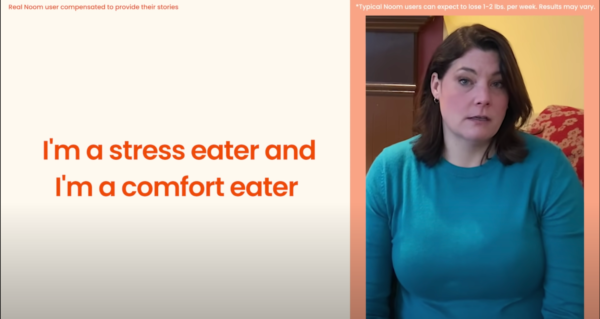
Timestamp: 00:18 - 00:22
Objection: Exercise never worked for me
“I worked out every day for a year and just lost 10 pounds. I've been doing Noom and I've already lost 14 pounds.”

Timestamp: 00:26 - 00:32
Objection: Diets never worked for me
“I've been on a diet for 30 years. Noom's approach is different. When I lost my first 10 pounds I knew that Noom was not only different but it was working.”

Key Takeaway #3 - Clear & Compelling Call to Action > 10 seconds
Let’s fast forward to the end of the video.
Many YouTube advertisers make a simple, easy-to-avoid mistake.
They do the very hard work of...
- Getting the viewer’s attention past 10 seconds…
- Building desire & curiosity for the offer…
But then, at the end of their video:
They don’t give their viewer enough time to actually click through and take the next step!
Don’t do this.
Instead, at the end of your video, make sure to give your viewer good reasons - and enough time - to actually click on your YouTube ad and take the next step in your sales funnel.
(10 seconds or more is a great place to start.)
Be like Noom here and:
- Have a clear next step for the viewer to take
- Make that next step compelling
- Give them enough time to actually understand it and actually click through
Here’s a screenshot from the ad showing how Noom does this:
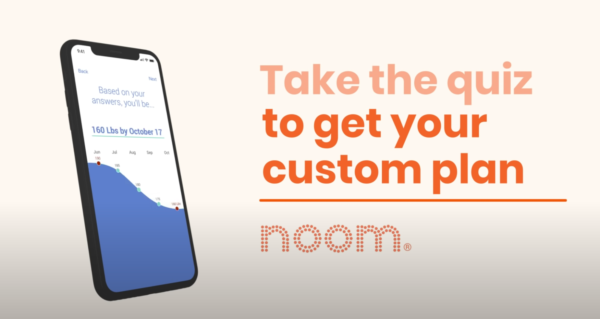
- Is it clear? Yes. We could possibly improve it by making it even more clear: Add specific instructions “Click the link to take the quiz & get your custom plan…”
- Is it compelling? Yes. “Quiz” generally provokes curiosity & “Custom plan” implies some kind of self discovery, which also will attract interest.
- Is it >10 seconds? Almost. It’s 9 seconds long. No harm in making it 15 seconds or more.
This Call to Action (CTA) section ensures that Noom will convert as many interested viewers as possible to clicks, and as a result, conversions.
On to our last takeaway from Noom’s ads…
Key Takeaway #4 - Test Different Lead Types + Lead with Emotion
Let’s zoom out a bit and think about overall strategy.
Weight loss is a crowded market. Again - your average adult will try 126 different diets in their lifetime.
There is a LOT of chatter out there. Folks will have heard diet / weight loss companies promise pretty much everything.
(Some people will have even tried most (or all) of these solutions already.)
Key Point: Pay attention to what your prospect already knows about their problem and your solution to that problem.
Two books go into great detail on this:
- “Breakthrough Advertising” by Eugene Schwartz (here is a great breakdown of one of the most important frameworks from the book: )
- “Great Leads” by Michael Masterson (the image below is adapted from one in his book)
Depending on where your prospect’s awareness is relative to , they will fall into one of Gene Schwartz’s 5 “Stages of Awareness” categories:
- Most Aware - they already know your product & are ready to buy again
- Product Aware - they know what you sell but aren’t yet sure it’s a good fit for them
- Solution Aware - they know the results they want, but not that they can get it from your product
- Problem Aware - they know they have a problem, but don’t know there is a solution
- Completely Unaware - they don’t even know yet that they have a problem

(Chart adapted from “Great Leads” by Michael Masterson)
Depending on which stage of awareness someone is in, they will respond differently to different “leads” or ad intros.
We can get into more detail on how these stages of awareness and lead types in a future post. But for now, here’s what to remember:
Key Point: Testing new leads is always going to be your highest leverage activity. And when possible, test new ads that lead with emotion.
Here’s one ad with over $1 million USD adspend that shows how Noom applied this approach:
Notice how in addition to the more direct intros / leads we have seen Noom use so far, they also use an emotion-heavy “Problem Solution” / “Story Lead” hybrid approach:
Noom Example Emotion-Heavy “Stacked” Story / Problem Solution Lead
Timestamp: 00:00 - 00:13
“I finally hit rock bottom when I realized for my 34th birthday I didn't want any pictures, I didn’t want a celebration. I just wanted to hide…”
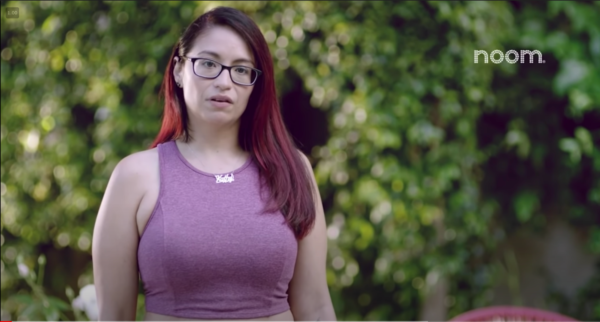
Timestamp: 00:13 - 00:25
“I just went on a nice cruise with my family and I was not in any of the pictures and I realize I can't live the rest of my life hiding from pictures.”
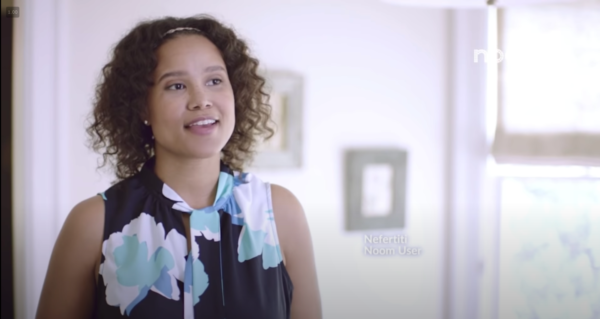
Timestamp: 00:25 - 00:33
“I feel like I covered up a lot when I was heavy and I would be jovial and the life of the party but I wasn't really happy inside…”
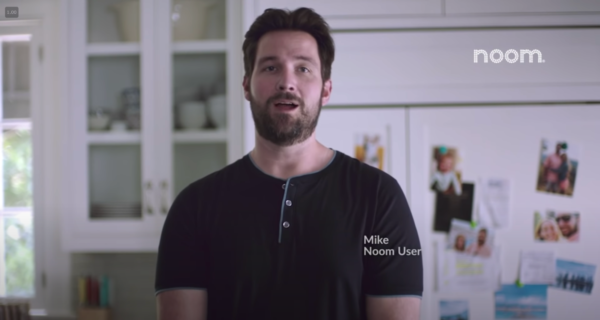
Notice how Noom leads here by presenting the “problem” (being overweight) in very emotional, personal terms for each of these users.
After 00:33 you’ll see this video transition to the “solution”, where each user shares how Noom helped them lose weight for good.
Creating Found’s YouTube ads
Ok now we’ve seen what worked for Noom. Now what are we going to do to create Found’s YouTube ads?
Modular Thinking: The “Lego Brick” Approach to Creating Ads
It’s helpful to think of ads in terms of their component parts or “bricks” that you can stack together to make a full ad.
(This gives you many options you can mix & match to test & find the best possible combination of ad elements)
Overview
When you’re making ads, It’s often helpful to visualize the 3 main parts of an ad and start by “scrapbooking” different elements from your research into these 3 main parts:
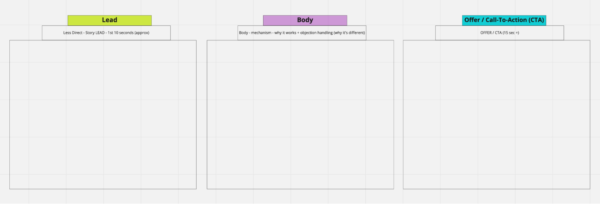
Miro’s virtual project collage space is a great tool for this initial brainstorm stage of ad creation. Here is a screenshot from the Miro board we used for this brainstorm.
(Watch the full 38 minute breakdown of how we “scrapbooked” our way to 6 new leads with Miro, here: https://blog.vidtao.com/making-youtube-ads-for-found-using-miro-part-1/ )
Creating Leads
Lead 1 - Overwhelming Stacked Social Proof Lead
Let’s start with an extremely direct lead, similar to Noom’s “Overwhelming “Stacked” Social Proof” lead.
By cutting & pasting social proof from Found’s review page, we’re going to see we have a ton of options here.
The home page has some very impressive results snapshots we could use (see below)
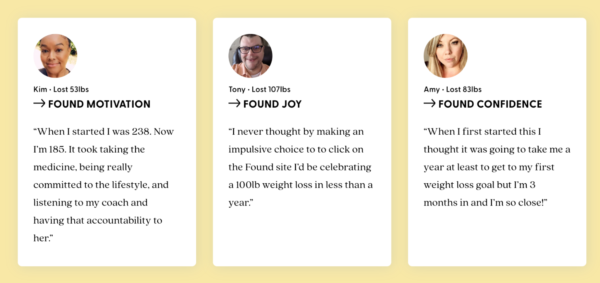
But on Found’s review pages there are literally hundreds more reviews, often with much more detail on the user’s personal situation:

For this first lead, we’ve taken a few of the most impressive weight loss results and “stacked” them together in the first 10 seconds:
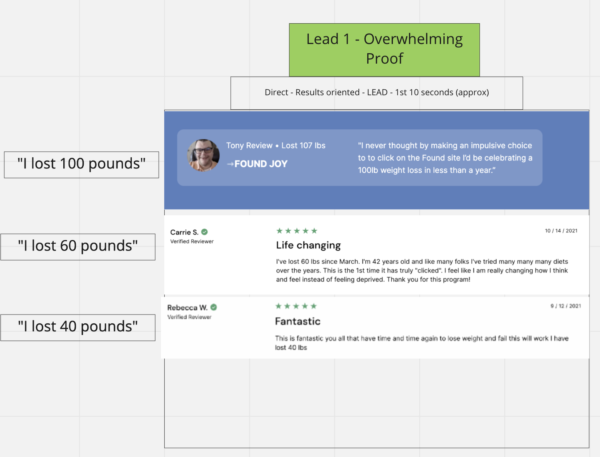
Footage:
Of course, now it’s up to Found to go out and get these users to create User Generated Content (like Noom did) so they actually have these result testimonials in video format.
Lead #2 - Emotional Story
Ok, now we have a direct lead. Let’s head to the opposite end of our lead spectrum and build a more indirect, story lead that connects more with our viewers’ emotions.
Again, there are many great examples from Found’s testimonials. But here was one that really stood out:
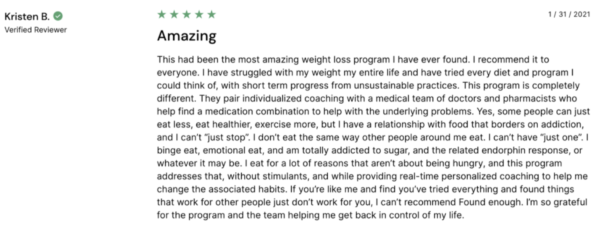
Here’s how we re-mixed the different elements from this testimonial into an entirely new lead:
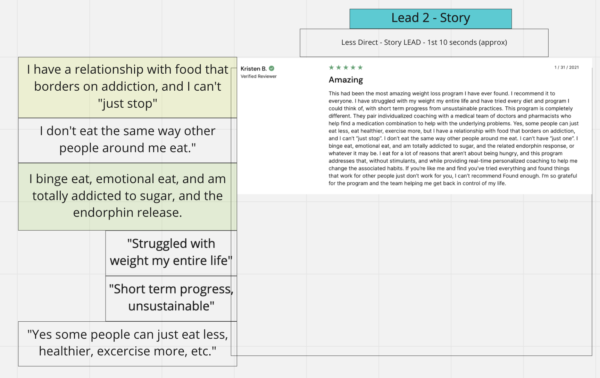
(This testimonial also gave us a nice transition to revealing Found as the solution, later on in the ad. We “scrapbooked” this also for a possible transitional element to use in ads:
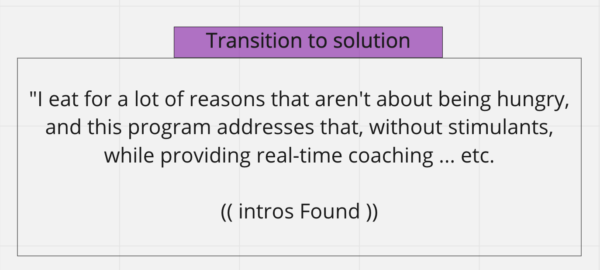
Lead #3 - Age-related story
“I can’t lose weight because I am [X] age” seems to be a common objection. To address this right out of the gate, here we’ve taken a couple of the older Found users and created a lead using their testimonials:
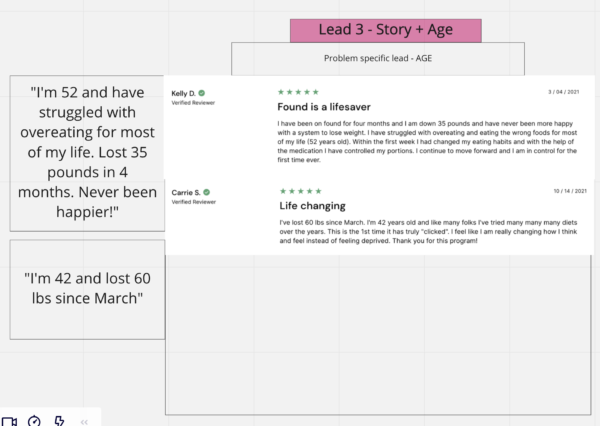
Lead 4: Post-pregnancy weight loss
Here we grabbed one of Found’s many post-pregnancy weight loss success stories to address this common situation:
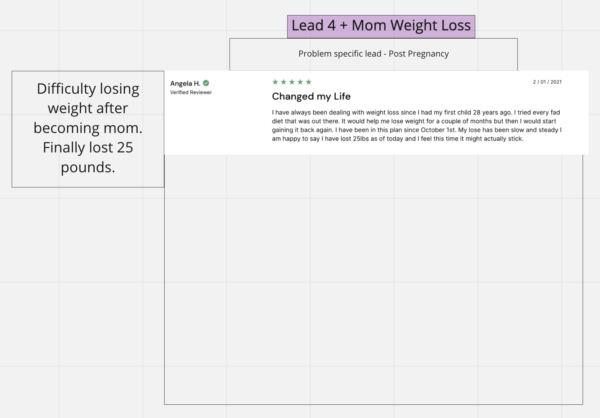
Lead 5 - Leading with why Found is different than other weight loss approaches
Here we addressed the “solution aware” element of the audience. We grabbed some of the many comments where people explained why Found is different from the many other weight loss approaches they have tried.
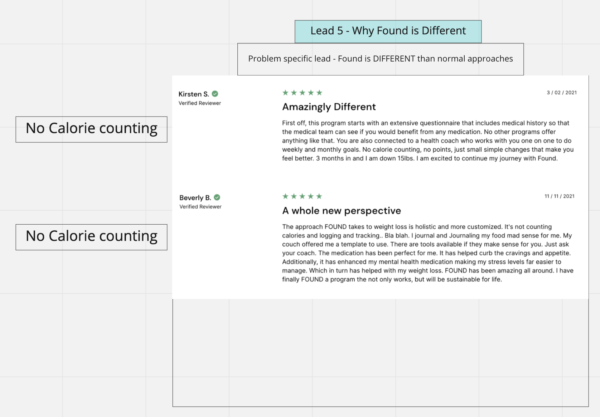
Lead 6 - Tease + eliminate common alternatives
Here we use a 2 part lead that targets a more solution aware audience:
Part 1: Catching attention by teasing with an amazing result (60 pound weight loss) followed by…
Part 2: Building curiosity by explaining what Found is not:

Where did we get these common solutions?
They’re from Similarweb’s data on some of Noom’s highest volume non-branded search terms.
These terms’ volume shows that they deliver high-intent traffic to Noom, so we’re going to call out the same terms in our ad here, to build more curiosity on exactly what Found is and why it works so well.
Next Steps…
Ok! We now have 6 leads to test. That was easy right?
Now onto the Body of the YouTube ad:
Creating the Body + CTA
Now that we’ve grabbed viewers’ attention with these amazing results & stories, they’re going to be wondering why Found is different & why exactly it works so well.
It’s time to create the Body + CTA of the ad.
How are we going to do this? Again - we’re simply going to re-purpose a lot of amazing info that Found is already using on their site.
(Here’s the full video walkthrough on Miro.
Let’s start with the Body…
Here’s the overview from our Miro board for this section:

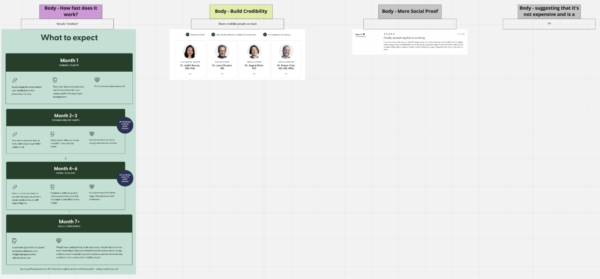
In the body of the ad, we’re going to explain how Found works, why this solution is unique and worthy of consideration, all while reinforcing these points with added social proof.
Again, remember that this market has tried MANY other solutions, likely without much success. Here in the body we need to:
- Explain how Found is different - how it actually addresses all the multiple factors associated with maintaining a healthy weight.
- Remove self-blame: the reason why other solutions haven’t worked in the past, is because weight care / weight loss / management is a complex process with way too many factors that most approaches don’t touch. It’s NOT because our viewer didn’t try hard enough, etc. etc.
Body element 1 - Why it works + “It’s not your fault”
Here we’ve extracted 2 elements explaining why Found works, why it’s different, while showing how it debunks the common “you simply need to eat less & move more to lose weight” concept is flawed:
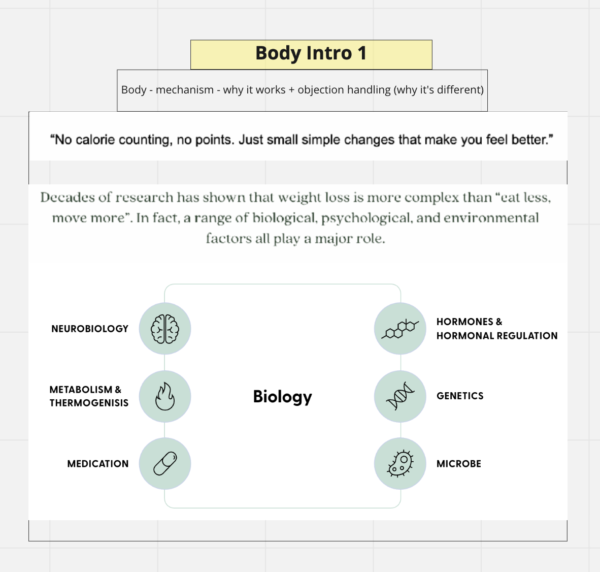
Body 2 - Genes + Hormones are to blame
In Body 2, we’re focusing more on the fact that 70% of your weight loss is determined by your genes + hormones, which most other approaches to weight loss can’t touch:
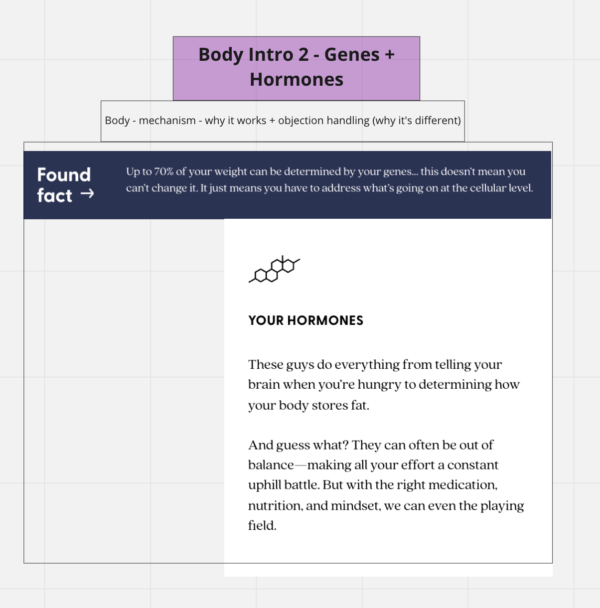
Now that our viewer clearly understands that Found:
- Helps people achieve amazing weight loss results (from the intro testimonials)
- Has a unique way of delivering results (addressing any skepticism)
Let’s explain a bit about how easy & straightforward it is to actually use:
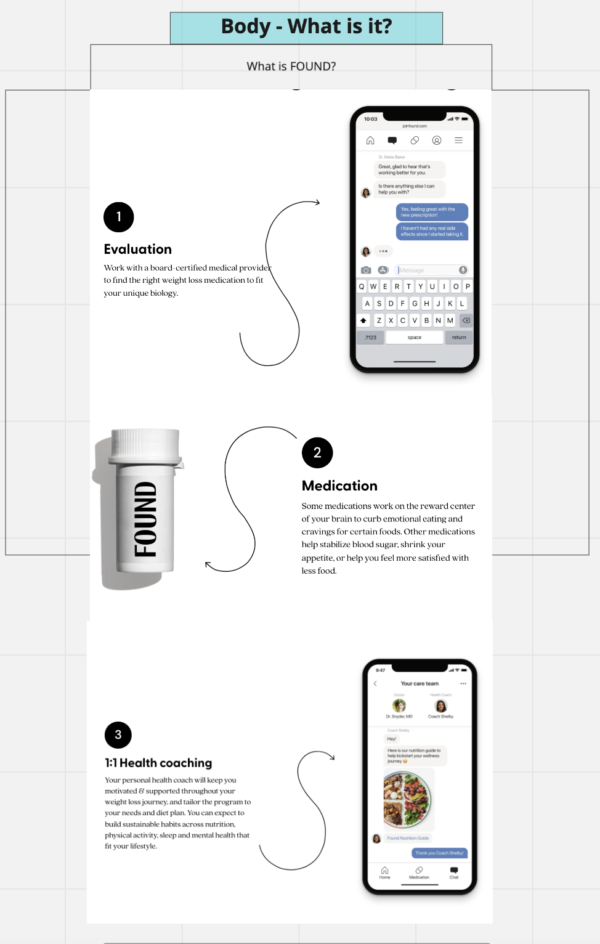
The process breaks down as:
- Step 1: Get an assessment from one of Found’s healthcare providers.
- Step 2: Curb your cravings with custom medication.
- Step 3: Stay on the path with 1:1 health coaching.
Now that viewers have some kind of context around how it works, let’s reinforce that Found does indeed work.
Time for some more testimonials!
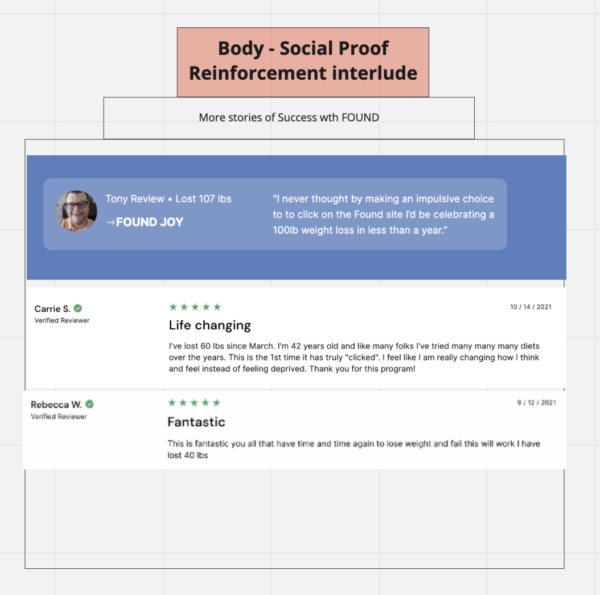
Body - Setting Expectations: Results Timeline
Again - this market has heard “Lose weight FAST!” promises again and again. Found stands out by setting a realistic timeline, because the service actually works and delivers sustainable results.
Setting expectations properly here helps add validity to the results around these results helps. So we’ve included this module from the sales page:
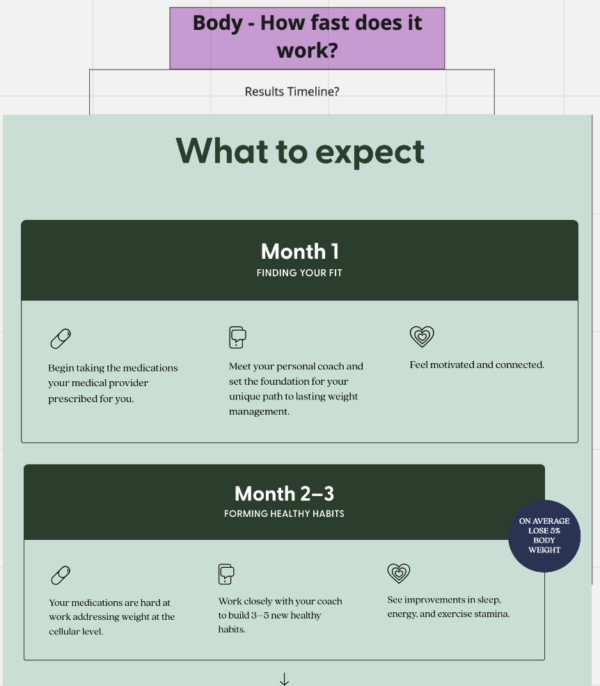
More Credibility…
While we’re on the topic of credible results, let’s mention who is behind this whole thing:
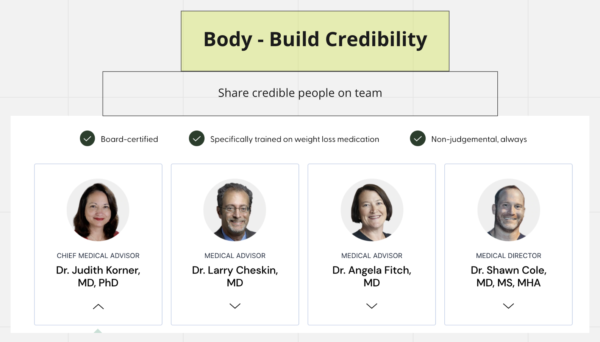
Let’s back this up with some more social proof…
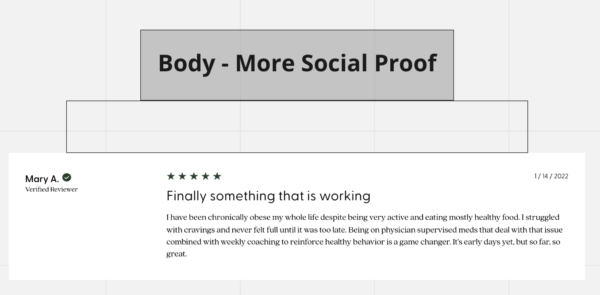
Ok - with all these elements in place, let’s make the pitch & invite our viewer to take action.
Call to Action (CTA)
Now let’s make the offer:
Take the free quiz and get your assessment:
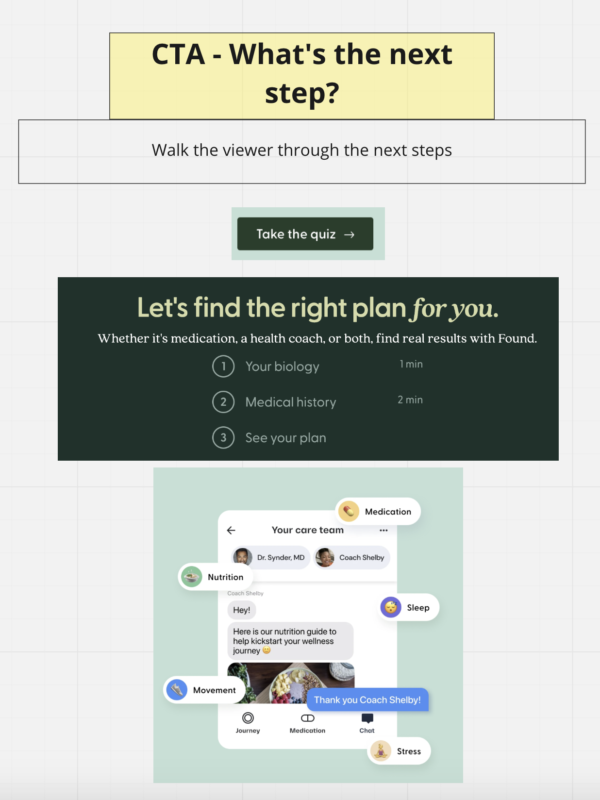
Key Point: In your voiceover here, be clear here about exactly what you want the viewer to do:
“Click the link with this video to take the quiz and get your free assessment… It takes just 3 minutes to get your custom plan and see how Found can help you accomplish your weight management goals asap…”
Call-to-Action: Social Proof Reinforcement - Talk about the quiz itself
Here we would ideally have a Found user reminisce about how taking this same quiz was
- Easy
- The first step on their path to their new life

Call-to-Action: Reiterate CTA
Sometimes you need to repeat yourself. And that’s what we’re going to do here.
Re-emphasize the CTA and walk the viewer through exactly what they need to do to take the first step towards their new weight & new life:
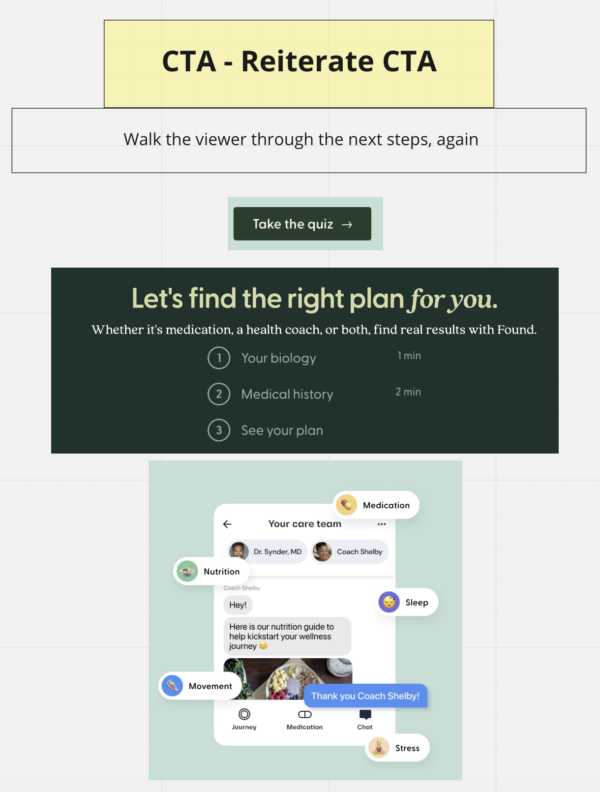
Call-to-Action: More Urgency
Now we need to emphasize why they need to click now, and not later.
In time limited promotions, you can talk about how this opportunity will end at X date, etc.
Here we are using more of an implied urgency that can work in any case:
We add a countdown timer to the ad, which will encourage more people to hurry up and click through before the video ends:
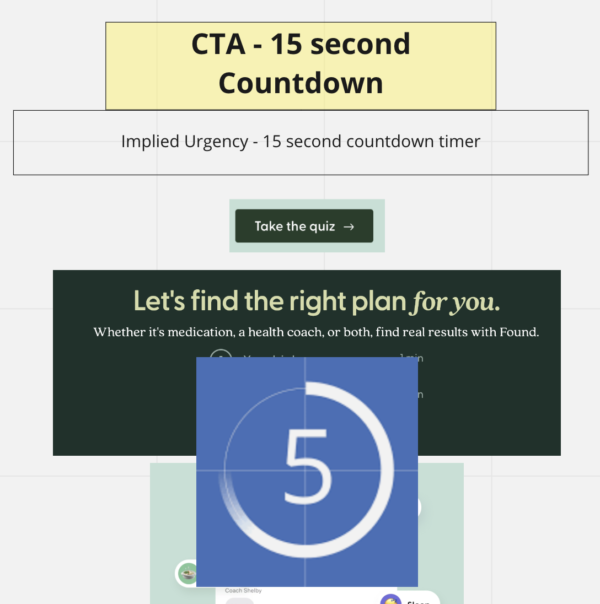
Call-To-Action: Final Social Proof
Close out the ad by piling on even more social proof, to overwhelm the viewer with evidence that Found is indeed the next step for them to finally achieve their goal weight.

Wrapping up…
Ok - in the process of walking through how Found can take Noom’s market share by leveraging YouTube ads, we just covered a TON about how to effectively build & run YouTube ads in 2022 (and beyond), including:
- How to use SimilarWeb to uncover your best initial YouTube ad targeting options
- How to use SimilarWeb & simple research to build out plenty of original, high performing YouTube ad variations
- Sponsored -
Inceptly: the performance video ad team behind $950M+ in direct response revenue
Inceptly High-Performance YouTube Advertising Agency
Inceptly builds YouTube ad creatives & manages over 5M USD/month in YouTube ad spend for companies like ClickFunnels, Descript, MindValley, Advanced Bionaturals, Organifi, and many more.
Are you spending over $1k/day on ads and looking to scale your business with YouTube ads?
Schedule your free YouTube ad brainstorming call here:
👉 inceptly.com/call
What are your YouTube ad questions?
In the meantime though, what questions do YOU have about YouTube ads?
Let us know in the Comments section below, and we’ll make sure to cover your question in an upcoming post.
Have a great week!
The VidTao Team
Sign up for VidTao.com: The Free Tool to Discover & Track Your Market's Best YouTube Ads.
Are you spending over $1k/day on paid traffic and want to scale with YouTube ads? Schedule your free YouTube ad brainstorming call here: inceptly.com/call
VidTao.com is brought to you by Inceptly.com - High Performance YouTube Ad Creative & Media Buying Agency Managing $5M/month+ in YouTube Ad Traffic.

